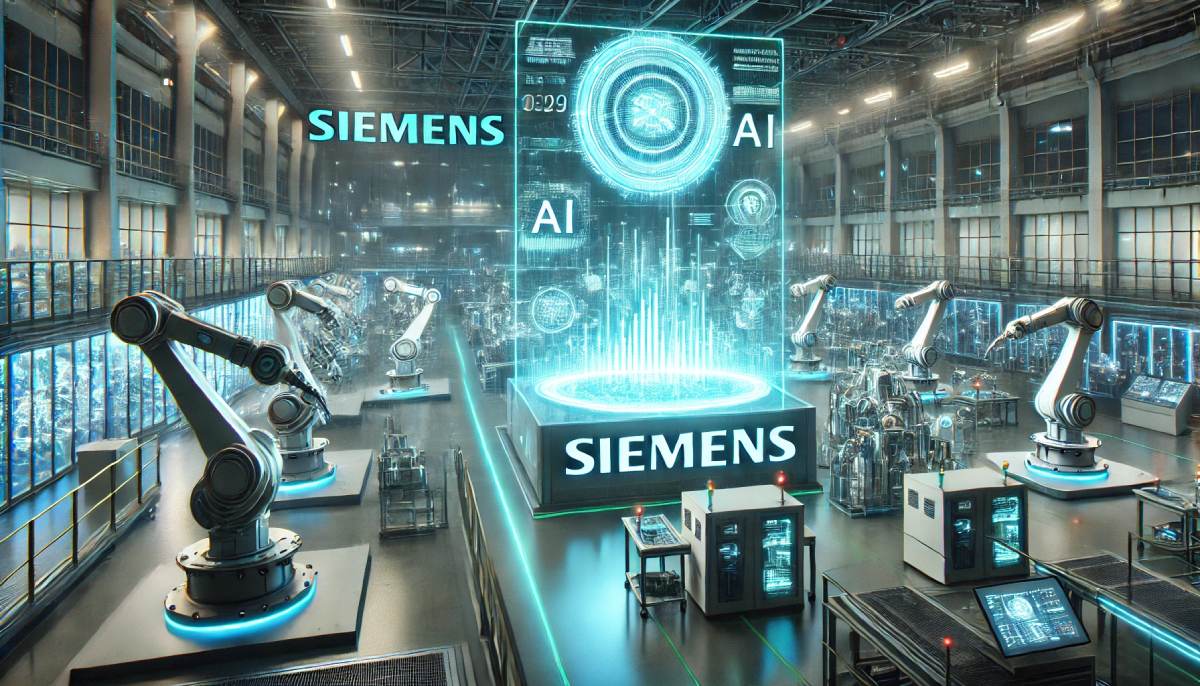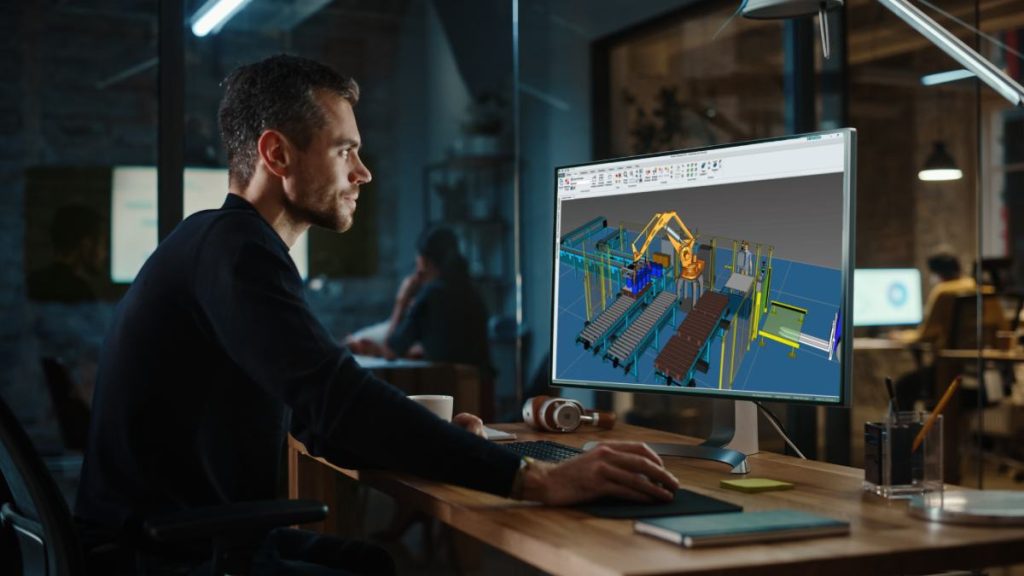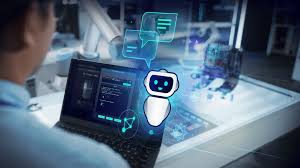Smart manufacturing is revolutionizing the industrial landscape, enabling factories to become more agile, efficient, and innovative. As a leader in digital transformation, Siemens is at the forefront of this shift, helping organisations harness the power of industry 4.0 and beyond.
Discrete manufacturers today face the challenge of producing more product variants in smaller quantities while maintaining operational efficiency and quality standards. Supply chain resilience has become a board-level priority due to various external factors that have highlighted the threat to business continuity. Smart manufacturing provides a roadmap for addressing these challenges by leveraging connected technologies, real-time data, AI-driven insights, and automation. By adopting smart factory solutions, manufacturers can enhance supply chain transparency, improve the connection between design and manufacturing, enhance utilization and delivery performance while staying competitive in a rapidly evolving market.
In this blog we will explore the key aspects of smart manufacturing, including the impact of digital transformation in manufacturing, the shift to Industry 4.0 and the vision of Industry 5.0, its transformative benefits, and how Siemens’ smart manufacturing solutions are driving the future of digital factories.
What is smart manufacturing?
Smart manufacturing is a broad term that encompasses the use of advanced technologies such as artificial intelligence (AI), the internet of things (IoT), cloud computing, the industrial edge and automation to optimise production processes. By integrating digital tools and real-time data analytics, discrete manufacturers can improve operational efficiency, reduce costs, and enhance product quality.
Key characteristics of smart manufacturing
- Interconnected systems: Seamless communication between machines, enterprise systems, and supply chains to facilitate more efficient production processes and identify supply chain vulnerabilities.
- Predictive maintenance: AI-driven insights that help identify equipment failures before they occur, reducing downtime and maintenance costs.
- Flexible production: Rapid adaptation to market demands, customer requirements, and product customization needs.
- Enhanced quality control: AI based visual quality inspection and machine learning algorithms analyze real-time data to detect defects and optimize production workflows.
- Sustainability and efficiency: Transparency around energy consumption, integrated energy-efficient processes, waste reduction strategies, and resource allocation to support sustainability goals.
How digital transformation is reshaping manufacturing
Digital transformation is not just a trend—it’s a necessity for manufacturers aiming to stay competitive in an increasingly technology-driven world. The integration of digital technologies into manufacturing processes is creating a widening performance gap between digital leaders and laggards. With a data-driven approach to production, companies can:
- Enhance operational efficiency – Digital tools like IoT-enabled sensors, AI-driven analytics, and cloud-based automation help manufacturers optimize production lines, reduce downtime, and streamline supply chains. Predictive maintenance powered by AI can detect equipment failures before they occur, minimizing costly disruptions.
- Improve product quality and customisation – Advanced data analytics and AI allow manufacturers to monitor quality in real time, ensuring that defects are caught early. Technologies like digital twins enable precise simulations, reducing errors and enabling the creation of highly customised products tailored to specific customer needs.
- Enable intelligent factories and industry 4.0 – The concept of Industry 4.0 revolves around interconnected intelligent factories where machines communicate seamlessly using IoT and AI. This leads to higher levels of automation, greater production flexibility, and a more agile response to market demands.
- Reduce costs and waste – By leveraging technologies such as cobots, autonomous and mobile robots, manufacturers can optimise resource utilisation, reduce energy consumption, and minimise material waste. Through digital monitoring and smart resource allocation, sustainable manufacturing practices become more achievable.
- Strengthen supply chain resilience – Digital transformation provides real-time supply chain visibility, allowing manufacturers to track inventory, forecast demand, and respond proactively to disruptions. Blockchain technology enhances transparency and security in transactions, reducing risks of fraud and inefficiencies.
- Enhance workforce productivity and safety – Automation and augmented reality tools assist workers in complex tasks, reducing human errors, increasing productivity and addressing skills shortages. Wearable technologies and AI-driven safety protocols enhance workplace safety by monitoring hazardous conditions and providing instant feedback.
Industry 4.0: From adaptive to autonomous manufacturing
Industry 4.0 represents the next chapter in industrial evolution, highlighting the transition from adaptive manufacturing to autonomous manufacturing, increasing efficiency and productivity through intelligent, interconnected factories.
Adaptive manufacturing, while a significant advancement over traditional manufacturing methods, relies on human intervention and predefined rules to respond to changes in production processes. This approach, though valuable, is inherently limited by the speed and flexibility of human decision-making and the constraints of rule-based systems.
On the other hand, autonomous manufacturing, facilitated by advancements in AI, machine learning, and Industrial IoT technologies, introduces a new paradigm where manufacturing systems can self-optimise, predict outcomes, and make real-time decisions with minimal human intervention.
This transition enables discrete manufacturers to achieve new levels of efficiency by automating routine tasks, reducing downtime through predictive maintenance, and dynamically allocating resources to meet changing production demands. As discrete manufacturers navigate this shift Siemens automated production operations and production line engineering solutions have emerged as a pivotal enabler of digital transformation.
Industry 5.0: Bridging human-machine collaboration
The vision of Industry 5.0 represents another transformative shift in manufacturing philosophy, moving beyond the pure automation and digitalisation focus of Industry 4.0 to embrace a more human-centric and sustainable approach. This vision emphasised the harmonious collaboration between humans and machines, where technology serves to augment human capabilities rather than replace them.
Industry 5.0 seeks to create manufacturing environments that prioritise worker well-being, environmental sustainability, and societal impact while maintaining high levels of productivity and innovation. The concept envisions factories where collaborative robots work safely alongside humans, where artificial intelligence supports rather than supplants human decision-making, and where production processes are designed to minimise environmental impact while maximising personalisation and flexibility. However, this future transition will be gradual, with many manufacturers still working to fully implement Industry 4.0 technologies.
Key technologies driving digital transformation
- Big data analytics: An increasing number of sensors and operational feedback is generating massive amounts of data. Advanced analytics help companies make sense of this data to improve decision-making and operational efficiency.
- Industrial IoT (IIoT): IoT-enabled devices connect machines, production lines, and enterprise systems to enhance real-time visibility and control.
- Cloud computing: Cloud-based platforms allow manufacturers to store, process, and analyze data at scale, improving collaboration and accessibility.
- Cybersecurity measures: As Operational Technology (OT) and Information Technology (IT) converge, manufacturers must invest in robust cybersecurity frameworks to protect sensitive data and critical infrastructure from cyber threats.
- Artificial intelligence supported by machine learning: AI-powered algorithms enhance predictive maintenance, quality control, and production optimisation.
Benefits of digital transformation in manufacturing
- Enhance productivity: Automated workflows and real-time monitoring optimise production lines, reducing human intervention and errors.
- Improve decision-making: Data-driven insights enable manufacturing leaders to make informed decisions that optimise production, supply chain management, and customer satisfaction.
- Increase sustainability: Digital tools help manufacturers track energy consumption, reduce waste, and implement environmentally friendly practices.
- Enable remote operations: With cloud computing and Industrial IoT, manufacturers can monitor and control operations remotely, ensuring business continuity in dynamic environments.
- Improve supply chain resilience: By integrating digital tools, manufacturers gain visibility into the supply chain, mitigating risks and improving responsiveness to disruptions.
As digital transformation continues to evolve, manufacturers that embrace these technologies will not only gain a competitive edge but also drive innovation, efficiency, and sustainability across their operations.
Smart manufacturing benefits: agility, efficiency & innovation
As technology continues to reshape the manufacturing landscape, smart manufacturing is becoming a critical driver of success. By integrating digital tools, automation, and AI-powered insights, companies can achieve unprecedented levels of agility, efficiency, and innovation. Smart manufacturing doesn’t just improve production processes—it transforms how manufacturers respond to market demands, optimize resources, and develop cutting-edge products. Organisations embracing smart manufacturing experience multiple benefits, including:
Agility in manufacturing
- Rapid response to market changes and demand fluctuations.
- Ability to switch production lines seamlessly for different product variants.
- Enhanced decision-making powered by real-time data analytics.
Manufacturing Efficiency
- Reduced waste: Minimising material waste while optimising energy consumption.
- Streamlined operations: Automation reduces bottlenecks, enhancing overall productivity.
- Optimised resource allocation: AI-driven insights enable precise inventory and workforce management.
- Enhanced process planning: Real-time understanding of manufacturing production planning, identifies bottlenecks, inefficiencies, and opportunities for improvement.
- Improved execution management: Intelligent automation and closed-loop feedback systems ensure seamless manufacturing execution.
Innovative manufacturing
- Exploration of concept designs: Using digital twin simulations engineers can virtually test, validate and optimise product concept designs, identifying potential issues and iterating on solutions long before committing to physical prototypes.
- Faster product introduction: Connecting design tools and re-using design data in manufacturing allows companies to move faster and achieve improved quality.
- Enhanced customer experiences: Intelligent factories can produce customised products using new manufacturing approaches based on real-time customer preferences.
- Integration of AI-driven insights: AI enhances predictive analytics, allowing companies to foresee market trends and adapt accordingly.
The future of digital factories is here, and Siemens is leading the charge in smart manufacturing transformation. By embracing industry 4.0 and preparing for industry 5.0, manufacturers can unlock new levels of efficiency, agility, and innovation.
With AI, IoT, and digital twins driving the next phase of industrial evolution, smart manufacturing is poised to redefine how factories operate. As businesses continue their digital transformation journey, the adoption of smart factory solutions will be critical to long-term success.

Smart manufacturing trends: AI, IoT, and Digital Twins
As manufacturers continue to embrace the principles of Industry 4.0 and consider the impact of Industry 5.0, trends in artificial intelligence (AI), the Internet of Things (IoT), and digital twin simulation technology are influencing smart manufacturing.
AI in manufacturing
The integration of AI into intelligent factories is transforming the way manufacturers approach decision-making and process optimisation. By leveraging advanced machine learning algorithms, AI-powered systems can analyse vast amounts of real-time data collected from IoT sensors across the factory floor, identifying patterns, predicting equipment failures, and autonomously adjusting production parameters to improve efficiency and quality.
However, the impact of AI extends far beyond just operational efficiency. These intelligent systems enable manufacturers to make more informed, data-driven decisions about product design, supply chain management, and strategic planning.
IoT in manufacturing
Closely linked to the rise of AI is the growing popularity of the Internet of Things (IoT) in smart manufacturing. By embedding smart sensors and connectivity throughout the factory floor, IoT technologies enable the seamless flow of data between machines, devices, and systems, facilitating real-time monitoring, analysis, and autonomous decision-making. Where environmental or space constraints limit the use of physical sensors, virtual sensors may be able to perform the same function using a software-based model to estimate physical variables.
This interconnectivity is the foundation upon which smart factory solutions are built, allowing for the integration of advanced analytics, predictive maintenance, and automated process control. As the IoT ecosystem continues to expand, manufacturers will have access to increasingly granular, real-time insights that can drive even greater efficiency, quality, and responsiveness.
However, with increased connectivity comes the heightened risk of cyber threats. Siemens addresses this challenge with its comprehensive cybersecurity solutions, designed to protect industrial networks and data from potential breaches. These solutions ensure that the benefits of IoT and smart manufacturing can be realized without compromising the security and integrity of the manufacturing environment.
Digital twin in manufacturing
Supporting both AI and IoT in the smart manufacturing landscape is the power of digital twin technology. By creating virtual, data-driven replicas of physical assets, processes, and even entire factories, digital twins enable manufacturers to simulate, test, and optimise their operations in a risk-free, digital environment.
Through the power of AI, IoT, and digital twins, companies will continuously create highly agile, efficient, and innovative factories that can thrive in the face of an increasingly complex and competitive global marketplace.
Frequently asked questions (FAQs)
Q: What is the difference between Industry 4.0 and Industry 5.0 in manufacturing?
A: Industry 4.0 focuses on automation, Industrial IoT, and digital transformation to optimise production processes. Industry 5.0 builds on this by integrating human creativity and expertise alongside advanced technologies, emphasising sustainability, ethical AI, and personalisation.
Q: How does smart manufacturing address sustainability challenges?
A: Smart manufacturing integrates energy-efficient processes, minimises waste, and optimises resource allocation using AI and IoT technologies. These innovations help manufacturers reduce their environmental footprint and align with sustainability goals.
Q: What role does Siemens’ digital twin technology play in smart manufacturing?
A: Siemens’ digital twin technology allows manufacturers to simulate, optimise, and validate production processes virtually before implementing them physically. This approach reduces costs, improves efficiency, and supports innovation.
Q: How do AI and IIoT enhance predictive maintenance?
A: AI algorithms analyse real-time IoT sensor data to predict equipment failures before they occur. This reduces downtime, improves equipment lifespan, and lowers maintenance costs.
Q: What is the significance of IT and OT convergence in manufacturing?
A: Integrating IT (data systems) with OT (operational systems) creates a unified digital ecosystem. This connection enables real-time data sharing, smarter decision-making, and enhanced operational efficiency.
Q: How are digital twins shaping the future of smart manufacturing?
A: Digital twins enable manufacturers to simulate and test operations virtually, optimise production, and implement closed-loop feedback systems. In the future, these systems will integrate with AI, blockchain, and 5G to further enhance precision and responsiveness.
Q: What advancements can we expect with adaptive automation?
A: Adaptive automation will leverage AI and machine learning to dynamically adjust production lines to changes in demand, product design, or material availability, ensuring greater flexibility and efficiency.
Q: What challenges do companies face when adopting smart manufacturing technologies?
A: Key challenges include integrating legacy systems with modern technology, managing the high upfront investment, ensuring workforce readiness through training, and maintaining robust cybersecurity.
Q: How can companies ensure data security in connected factories?
A: By implementing advanced cybersecurity measures such as encrypted communications, secure IoT devices, and continuous monitoring for potential threats.
Q: What is an Executable Digital Twin (xDT)?
A: An executable digital twin is a virtual model of a physical asset or process that can simulate real-world behaviour, enabling organisations to optimize operations, predict failures, and test improvements before implementation in the actual system.
Q: Can digital twins be used in both Greenfield and Brownfield projects?
A: Yes, digital twins optimise new Greenfield facilities through virtual design and validation while enhancing existing Brownfield facilities by simulating and implementing process improvements without disrupting operations.
‘This content is written by Siemens DI SW. As a proud Siemens partner, we are committed to delivering trusted insights and solutions.’



